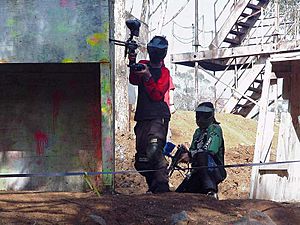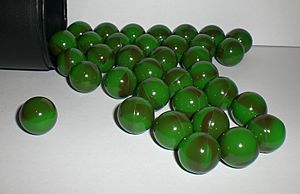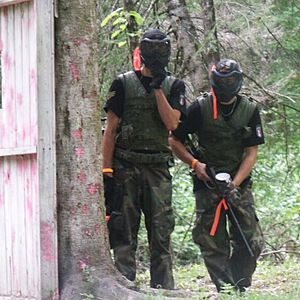Paintball facts for kids
Paintball is an exciting sport where players try to tag their opponents. They do this by shooting them with balls of colored dye. These special balls are called "paintballs." Players can play in teams or on their own.
Paintballs are shot from a device called a paintball marker, or a paintball gun. When a paintball hits a player, it bursts and leaves a mark of dye. This mark shows that the player has been eliminated from the game. Paintball is often played as an organized sport, with leagues, tournaments, and even professional teams.
You can play paintball indoors or outdoors. The games happen on special fields designed for the sport. These fields have natural things like trees or artificial obstacles like barrels. Players use these to hide behind and plan their moves. The goal of the game can change. Sometimes, teams try to capture a flag from their opponents. Other times, players might need to defend a certain spot on the field. Or, the goal might simply be to eliminate all other players until only one person or team is left. Games can be very quick or last for many hours, depending on the rules.
Many countries have special laws for paintball to keep everyone safe. Players must always wear protective gear, especially masks. Game rules are also strictly followed. Paintball is also used by the military and police to help train new recruits.
Contents
What You Need to Play Paintball
To play paintball, you need some basic equipment. What you use might depend on the type of game you play. It also depends on how much you want to spend. But almost every player uses these three main things:
Paintball Marker (Gun)
This is the main piece of equipment. It's used to shoot paintballs at other players. Your paintball gun needs a "hopper" or "loader" to hold the paintballs. This feeder sends the balls into the gun. Modern paintball guns use a tank of compressed air or CO2. Compressed air is usually better for newer guns.
Paintballs
Paintballs are the ammunition for your marker. They are round gelatin balls filled with a special dye. This dye is safe for you and the environment. It's made of things that dissolve in water. Good paintballs are very round and have a thin shell. This helps them break easily when they hit something. They also have a thick, bright fill that is hard to wipe off. Most paintballs today are biodegradable, which means they break down naturally. They come in different sizes, like 13mm (0.50 inches) and 17mm (0.68 inches).
Mask or Goggles
Masks are super important safety gear. Players must wear them at all times on the field. They protect your face, especially your eyes, mouth, ears, and nose, from paintballs. Old masks were like safety goggles. Today's masks are much better. They cover your whole face. A good mask will also help prevent fogging so you can see clearly. Not wearing a mask can cause serious injuries.
Other Useful Gear
Many players, especially those who play often or in tournaments, use extra gear:
- Pods and Pod Packs: Pods are plastic containers that hold extra paintballs. They usually have flip-open lids. Pods come in different sizes, with 140-round pods being popular for tournaments. Players carry these pods in "pod packs" or "harnesses." These packs make it easy to grab more paintballs during a game.
- Squeegee/Swab: Sometimes, a paintball might break inside your gun. This covers the inside of your barrel with paint, which makes your shots less accurate. A squeegee or swab is a tool to clean the barrel quickly.
- Paintball Jerseys and Pants: These are special clothes with padding. They help protect players from paintball hits and from falling on hard ground. Some designs even help paintballs bounce off more easily.
- Elbow and Knee Pads: These pads protect your joints from impacts. They are usually soft foam worn inside your pants.
- Gloves: Getting hit on the hands can be very painful. Padded or armored gloves protect your hands while still letting you move your fingers easily.
- Athletic Supporter: This is important for protecting sensitive body parts. Guys often wear a jockstrap with a hard cup. Girls often wear a pelvic protector and a padded sports bra.
- Hats/Bandanas: Many players wear something on their head. This protects their forehead from direct hits and stops sweat from getting into their mask.
- Remote Lines: This is a hose that connects your air tank to your gun. It lets you carry the heavy air tank in a backpack or harness. This can make your gun lighter and easier to move around with.
Playing Fields
Paintball fields have many obstacles. These obstacles block your view of opponents and make it harder for them to shoot you. They can be things like shelters, fallen trees, barrels, or large tubes. In modern "speedball" tournaments, players use inflatable vinyl shapes of different sizes as obstacles.
Different Ways to Play
Scenario Paintball
Scenario paintball games try to be very realistic. They are often based on a story, like a historical battle or even an alien invasion! These games use props, special characters, and sometimes even vehicles. Scenario games usually last much longer than other types, sometimes for 12 hours or even several days.
Capture the Flag
There are two main ways to play Capture the Flag:
- Two Flags: Each team has a flag at their base on opposite sides of the field. The goal is to grab the other team's flag and bring it back to your own base.
- Center Flag: There is only one flag, and it's in the middle of the field. The goal is to get the flag and carry it to the far side of the field, usually the opponent's starting area.
Elimination
In Elimination, the goal is simple: get rid of everyone on the other team! Games usually last about 15-20 minutes. However, "big games" can last for hours. In big games, players who get eliminated might be able to rejoin the game after a certain amount of time.
Images for kids
See also
 In Spanish: Paintball para niños
In Spanish: Paintball para niños









